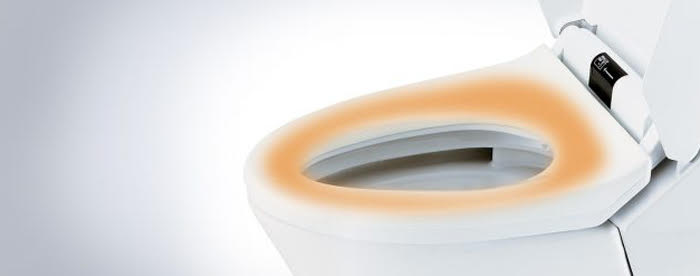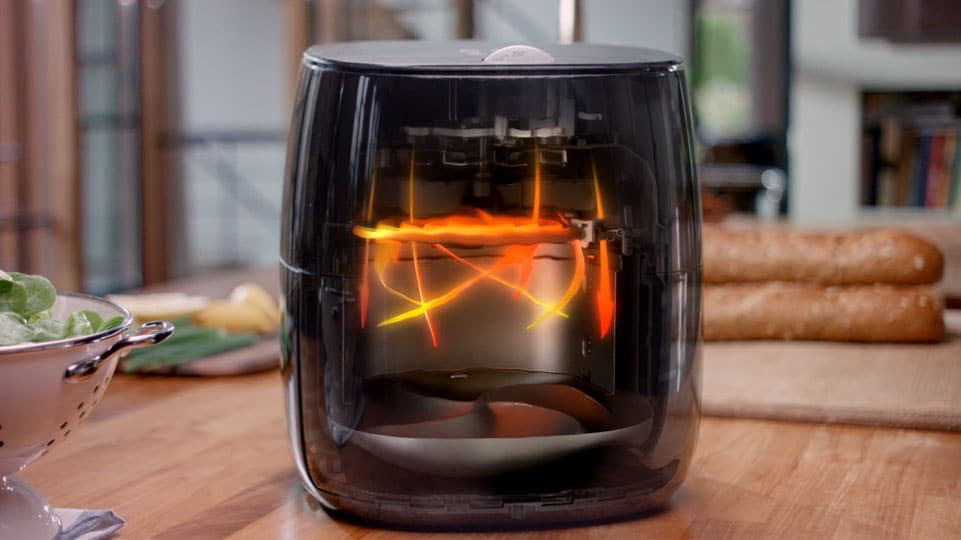
Art | Resources
Heated Plastic Toilet Seat
Question from John S
Hi Debra,
I love your site — you’re my go-to for the final word on toxics in our household.
We recently purchased a bidet seat for our toilet Bio Bidet Slim ONE Bidet Smart Toilet Seat in Elongated White with Stainless Steel Self-Cleaning Nozzle, Nightlight, Turbo Wash, Oscillating, and Fusion Warm Water Technology. When we received the package, we were dismayed to find that they proclaim the seat is made of “fire retardant ABS resin”.
I read in another one of your Q&A’s about ceiling fan blades that ABS plastic is most likely non-leeching in it’s final form, however this bidet has heated seats, as well as a tank of water in the back that it heats up.
Would you be concerned about sitting on a heated plastic toilet seat such as this? Or having the water spray on you from a (presumably) plastic tank?
We would love to know your thoughts. Thanks!
Debra’s Answer
I personally wouldn’t do this. Generally hard plastic doesn’t outgas, but when heated it DOES outgas.
I wouldn’t use this at all.
The Many Ways Carbon Felt and Fabric Can Help You Breathe Cleaner Air
I just want to tell you about a material that I’ve known about for a while, but am just learning all the ways it can help us with air pollution problems.
 The material is ACTIVATED CARBON in the form of FELT or FABRIC, a non-woven fiber made of pure anthracite activated carbon.
The material is ACTIVATED CARBON in the form of FELT or FABRIC, a non-woven fiber made of pure anthracite activated carbon.
Anthracite is naturally occurring mineral. It has the highest carbon content (between 92% and 98%.) and the fewest impurities and is the highest ranking of coal.
Most activated carbons are made from charcoal, which is made by burning various animal and vegetable materials.
So this is an extremely pure type of activated carbon.
Because it is made from 100% carbon, activated carbon felt has the advantage of being able to adsorb a large volume of volatile pollutants at a fast speed. It is widely used in solvent recovery, air purification, water treatment, gas masks, cigarette filtration, and in many other applications.
A sheet of activated carbon felt can adsorb volatile chemicals of many types in applications where an air filter may be impractical.
- emissions from interiors of new and used cars
- emissions from new mattresses
- smoke odors from furniture
- fragrance chemicals
- pet odors
- moldy odors in basements, lofts, and attics
- air freshener odors
- sofas
- kitchen and bathroom cabinets
- carpets
The limitation to using activated carbon felt is it cannot be sat on or washed because it contains no additives to bind the carbon together. To use, it needs to be encased in layers of natural fiber fabric. Place it in sun or wind to regenerate.
You can order Carbon Felt at Nirvana Safe Haven.
Carpet Problem

Question from Karen
Hi Debra,
There was work done recently in my apartment to make the floors less squeaky because it was bothering tenant below me. I have wall to wall carpeting and so what the maintenance guys did was drive multiple (30+) metal screws through the carpets to secure the floor boards more tightly. The screw heads were then sheared off.
I’m reacting strongly to whatever they did. No glues were used, just the metal screws. So I’m guessing the screws might have had a heavy coating of machine oil on them . Can’t think of anything else I could be reacting to. And it’s making me quite sick.
Do you have any suggestions for a carpet cleaner? The building manager is willing to clean the carpets for me. Any other suggestions? Im guessing I will need to ask them to rinse out the tank of the cleaner to get rid of the usual chemicals they use. What would be good for cleaning the carpet cleaner?
Thanks for your help. I’m having one of those domino effects since they did this work in my apt a few weeks ago and just reacting strongly to everything now.
Debra’s Answer
It sounds to me like putting the screws in your carpet opened up the latex adhesive layer in the carpet and also perhaps formaldehyde emissions from the subflooring.
Do you know the exact locations of where the screws are?
Foil for sure would block the emissions.
The challenge here is how to put something over the screws to block the emissions.
I don’t think cleaning the carpet would do it.
Readers, any ideas?
Yes there IS a Toxic Free Leather Sofa!
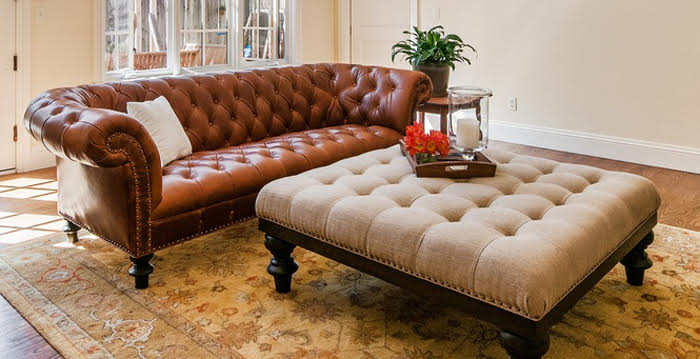
Custom leather sofa from Pine Street Natural Interiors
A few weeks ago one of my clients asked me if there was such a thing as a leather sofa without toxic chemicals. She knew leather sofas are usually filled with toxic polyurethane foam and fire retardant chemicals, plus there are more chemicals used to tan the leather.
I hadn’t heard of a nontoxic leather sofa, but I asked my friend Rowena Finegan, owner of Pine Street Natural Interiors, and she said she could make one for me, and yes, there IS natural leather!
Rowena has developed her own line of custom upholstered furniture called Inside Green.
Here are the materials used to make an Inside Green sofa:
-
- FSC certified Wood Frames and Legs: Wood frames are made from sustainably grown Alder from well-managed American forests
- Non-toxic Fasteners and Finishes: Each piece of wood is fastened with steel screws, and double-doweled with non-toxic, water based glue. A combination of hemp webbing, jute, and hemp burlap finish out the frame.
- Cushions: Layering of your choice of wool fibers, or organic goose feathers and down, with 100% pure natural latex padding. Premium quality wool batting comes from regions where the soil is continually turned, pesticides are forbidden, and sheep are still herded with the use of guardian dogs. Goose feathers and down are sourced from farms that raise geese for food consumption—completing a vertically integrated business model which is both financially and ecologically beneficial to local economies and the end consumer. The totally chemical-free feathers and down are separated by hi-tech machinery and are washed in biodegradable emulsifiers before being packed into 250-thread-count, 100% organic cotton covers.
- Pure, Petroleum-Free Latex: The foam that both covers the frame and is used for the cushions is natural latex, harvested from an environmentally friendly renewable resource procured from rainforest trees.
- Upholstery: organic cotton/hemp canvas. All fabrics presented with the line have been laundered in chemical-free vegetable-based laundry detergent and are either certified organic or have been produced using chemical-free base cloth and vegetable or low impact dyes.
- Finishes: WOCA natural oil stain—plant-based, sustainable, and non-polluting and contain no artificial pigments or preservatives. Along with being a naturally durable substance, oil-based stain also protects against scratches and indentations better than a standard urethane finish.
A sofa can be built in any size or style using these materials, and you can also get it upholstered with the healthiest leather I’ve seen.
EcoPell vegetable-tanned leather is made in Germany. Rowena loaned me a sample book and swatches to take to my MCS client and she had no reaction at all. The swatches actually just smelled like natural leather—no chemical smell. See all the leather colors and weights you can choose from.
This leather is regularly tested for chemicals frequently found in leather and publishes their test results. It has been certified by several organizations as being particularly environmentally-and allergy-friendly.
There is actually so much information about any and how this leather is good you just need to go to their website and read all about it.
This exceptional leather sofa is not inexpensive, but it CAN be made—in any size, style, and color that you desire.
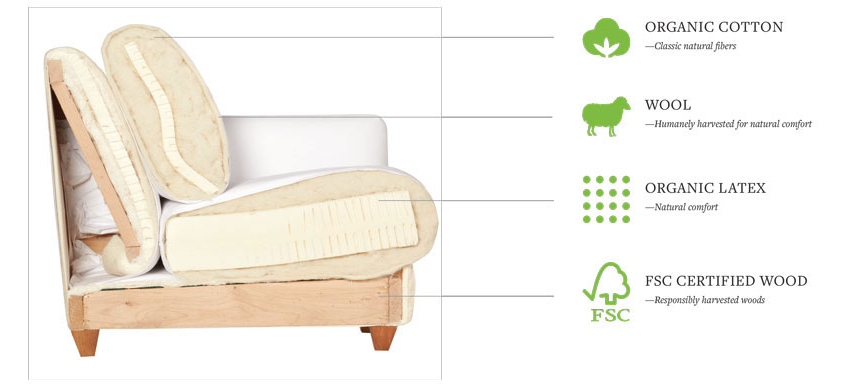
FINDING HEATERS FOR “BAKE OUTS”
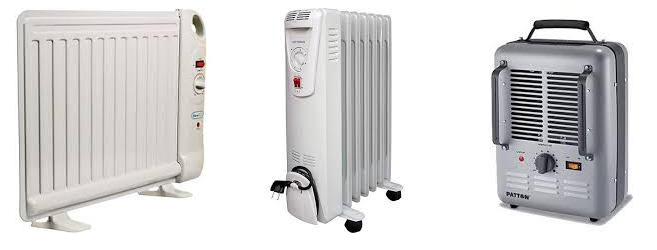
Five years ago I posted INSTRUCTIONS TO “BAKE OUR” TOXIC FUMES, which originally appeared in my now-out-of-print book Home Safe Home. Many readers since have used this method of heating rooms to make chemicals from paints, finishes, and other building materials outgas more quickly.
I’ve done this many times over the years, like when I would paint a room before there was no-VOC paint. I would just put my oil-filled radiator space heater in the room, close the door, leave it overnight, and in the morning open the windows and that was all that was needed.
Occasionally someone would call me and say I need more heat. How hot does the room need to be? I tell them to rent “an industrial heater.” And they do and it worked.
A couple of weeks ago I received an email from a reader saying the method wasn’t working for her. She heated up her space, even individual rooms, and the smell wasn’t decreasing.
We’ve been trying to figure out what she should do and the only thing I can come up with is “more heat.”
But she was’t able to find a heater.
I went out to look for heaters as well.
If you have done a bake out and needed more heat than ordinary room-size space heaters, please leave a comment and let us know what type and size heater you used and where you got it. Please be as specific as you can.
Here are some things I learned.
There are three key numbers to understand when looking for a heater: watts, volts and BTUs.
Watts are the amount of energy you need to power the heater.
Volts are the amount of energy coming out of an electric plug. An ordinary house electric plug is 110 volts. Some plugs, such as those for electric clothes dryers and electric stoves, are 240 volts.
BTUs are the measure of heat that is produced by the heater.
To get enough heat for a bake out, you need to use a heater (or heaters) to provide enough heat for the size of the room. The general rule of thumb is you’ll need roughly 10 watts of heating power for every square foot of floor area in the room. So a 1,500-watt heater can be the primary heat source for an area measuring up to 150 square feet (that’s 10’ x 15’).
My oil filled radiator heater uses a 110 volt plug, can be set to produce various amounts of heat up to 1500 watts, which is enough to heat 150 square feet.
This article is very thorough about different types of heaters and how to choose one for energy efficiency, but it will also help you understand types of heaters for bake outs: SYLVANE: Heater Buying Guide
One problem my client is running into is that she has an open plan of 600 square feet, so that would require the equivalent of four 1500 watt heaters.
A problem I run into is I am usually living in older houses with older wiring and I blow out the circuits.
I did find an electric heater at an equipment rental place that runs on a 240 watt plug, but my client’s stove is gas and she doesn’t have a clothes dryer, so she doesn’t have the plug. And it’s for professional use only.
OK that’s all I’m going to say on this.
Anyone have any knowledge or experience about heaters?
Let’s figure this out together so we have this data here.
Removing Sizing From Fibers

A reader wrote to me last week asking:
I have gone through about 4 different companies flour sack towels only to find they don’t absorb even the smallest amount of water. What happened? They used to be like paper towels and absorbed everything. What has been added to them to make them like polyester? They just smear the water around. Were they “conditioned” with something? It’s like using linen or polyester. Do you have any suggestions of a company that carries the old fashioned ones?
But before I could post her question, she wrote back and said:
No need to post my question as I figured it out! Yea!
For others if you ever get asked, they are now putting sizing in fibers, not just the material as a whole which means they soak up no water. So, soak in vinegar for 1-2 days and it eats it off, then wash like normal.
I did just one and compared it to an untreated one and was happily shocked to see the change.
Also vinegar is an amazing rust remover. I needed to refinish an indoor door and the hinges had some rust on them. I soaked in vinegar for a day and the rust just floated off. Be careful tho, I also soaked what I thought was a copper lamp base, but turned out it was layered over pewter and the vinegar ate the finish and left the pewter. Dang! Thanks again.
Airfryer
Question from Gustavo
Hi Debra,
Do you have any concerns for Airfryer? Can’t seem to find your comments regarding this on your website! I wonder if they are safe for use or are as dangerous as microwaves
Thank you!
Debra’s Answer
My concerns about the Airfryer are the same as with any other cookware or cooking appliance: nonstick finish.
Plus the circulating air is 390 degrees F, which can make nonstick finishes outgas. And if there are other plastics involved, they will outgas too.
I personally don’t fry or airfry. I eat foods raw, steamed, water-sauteed, roasted, baked, or dehydrated.
“Chemical-Free” Certification

Last week I had a correspondence that went like this:
Hi Debra,
I just discovered your site and I am loving it! Thanks for creating such a wonderful resource.
I am currently looking for a non-toxic mattress and have narrowed things down based on cost and certifications.
My top choice right now is Sleep on Latex, they seem to have all the right certifications, Oeko Tex, GreenGuard Gold and Eco Institute.
But, I am curious as to why they don’t appear in your article recommending non-toxic mattresses. I don’t want to buy the wrong thing! 🙂
If possible, could you let me know what your thoughts are on Sleep on Latex?
Many thanks in advance.
All the best,
Jane
And I replied:
There are better mattresses available. The certifications you mentioned aren’t organic. Since there are organic mattereses available, I’m focusing on those.
And Jane said:
thanks for clarifying your focus — I am trying to weigh eco-friendly certifications with cost, so the focus is different for me, I don’t much mind whether it is or organic or not as long as the chemicals or not in there! :0
And I said:
Be aware that Oeko Tex, GreenGuard Gold and Eco Institute certifications do NOT mean “chemical-free.” They test for an incomplete list of chemicals, so the products may still contain toxic chemicals not on their list.
“Organic” means “NO chemicals.”
Debra 🙂
Reading this I just want to be really really really clear that if you “don’t want chemicals” BUY ORGANIC. I don’t know what Jane thought organic meant, but organic is the highest standard for “chemical free”.
Safe Bassinet for Baby
Question from Eugenia
Hi Debra,
I have a question regarding baby bassinets in North America. It has been impossible for me to find a “clean” bassinet for my baby. I wrote to two different companies, Halo and Monte, to inquire about their manufacturing.
Both use plastics and foam in their products.
Halo said this of their “organic mattress”:
The Halo Bassinest is manufactured in China. The mattress that is included with the Bassinest is a standard manufactured polyurethane foam and covered with a polyester fabric cover. Both foams are polyurethane but the Organic mattress is certified for non VOCs. Eco friendly refers to the manufacturing environment. The foams are not sourced at the same factory.
Both the organic and standard mattress share these call outs-
No flame retardants
No harmful chemicals
No vinyl
No formaldehyde
No PVC
Phthalate-free
The organic cotton mattress(sold separately) is made from the finest non-toxic materials with the comfort and safety of your baby in mind. Its cover is made of 100% certified organic cotton fabric with a food-grade, water-resistant coating. Easy-to-clean and stain resistant, our organic cotton mattress also provides a hypoallergenic dust mite barrier. To provide the safe and comfortable support your little one needs, the mattress is made with ECO-friendly foam, uses NO flame retardants and emits NO harmful chemicals. It does not use any vinyl or PVC, and is Phthalate-free. Made specifically to fit the HALO Bassinest with its hourglass shape, it is an ideal safe sleep surface for your little one.
• 100% certified organic cotton cover with a food-grade, water-resistant coating that is easy-to-clean.
• Made with ECO-friendly foam. No flame retardants.
• Non-toxic design is safe for your baby. No vinyl, No PVC, and Phthalate-free.
• Meets the California Section 01350 Standard for harmful emissions.
• Oeko-Tex Certified.
• Hypoallergenic / dust mite barrier.
Monte wrote:
Vintex’s products do not contain any of the following materials :
• Latex
• DEHP (di-ethyl hexyl phthalate)
• BPA (bisphenol A)
• Formaldehyde
• Brominated flame retardantsVintex’s products do not contain any of the 84 chemicals listed in the REACH regulations. (reference EC 1907/2006, updated 18 June 2012)
The chemicals listed in California Proposition 65 were reviewed. Based the form of these materials in Vintex’s products, and the exposure levels expected from normal uses of the products, there is no requirement for warning labels as described under this regulation. (reference State of California Safe Drinking Water and Toxic Enforcement Act of 1986, updated 2 Nov. 2012)
None of the materials mentioned in the Designated Substance List are present in Vintex’s products in concentrations greater than the maximum exposure limits. (Ontario Regulation 490/09 – December 2009
The following materials are not intentionally added to any of Vintex’s products : Arsenic, Bismuth, Cadmium, Chromium, Cobalt, Lead, Manganese, Mercury, Selenium, Thallium.
All of Vintex’s products contain less than 10 ppm of Lead, Cadmium, Mercury or Chromium, and less than 20 ppm of Arsenic, as per ASTM D-1976-07, using EPA 3052 digestion.
In addition to the above statements, Vintex products that have the Safe Guard certification (Vintex’s V-Care and SoffTICK product lines, and some athletic products) are lead-free and phthalate-free, as defined by the CPSIA. (Consumer Product Safety Improvement Act of 2008)
It looks to me like neither company is making non-toxic bassinets. Is this correct? Would buying one of these bassinets second-hand (3+ years old) have off set some of the chemicals released by these materials?
Many thanks for your amazing help.
Debra’s Answer
The problem with this kind of description is that you can say that the product DOES NOT contain a whole list of chemicals, yet it still DOES contain toxic chemicals that are not on the list.
This is why I look at the actual materials present to see if they are toxic.
I would say neither of these bassinets are nontoxic.
See the image and caption at the top of this post for an all natural/organic bassinet. These are available through small businesses, but not yet from major brand names (as far as I know)
Another option is the “Moses basket” which is made of natural plant materials. Often these are painted or synthetic materials are sewn inside. Best to get one that is all natural and add your own mattress and bedding.
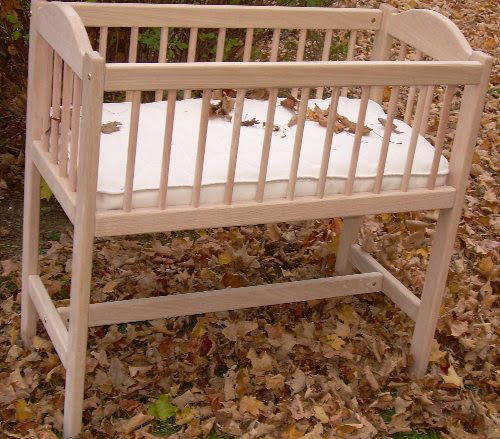
Americana Bassinet “A simple soild wood bassinet hand crafted by the Amish from Oak. Finished in a natural danish oil/ linseed oil mix or unfinished. Comes with an organic cotton/ wool latex mattress.” You could replace the latex mattress with a certified organic cotton bassinet mattress from Naturepedic |
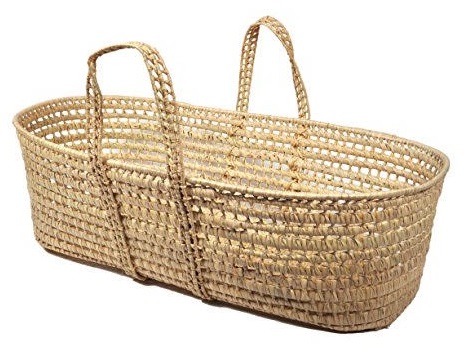
Moses Basket: Tadpoles All Natural Organic Storage Basket “The classic moses basket is perfect for your baby. Made from 100% all natural woven palm leaves, these baskets are all completely handmade in Morocco.” |
Non Toxic Outdoor Gas Grill
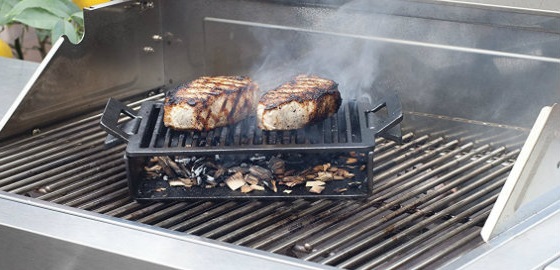
Question from Richard
Hi Debra,
Looking to purchase a toxic free gas grill for my sons. All I find so far all include at Prop 65 warning. Is there any grills made with toxic parts?
Thank you.
Debra’s Answer
This is like asking me are there any nontoxic cigarettes.
And the answer is no.
The whole act of grilling and BBQ is toxic.
The smoke itself has a long list of toxic chemicals.
The blackened meat has toxic chemicals.
It really doesn’t matter what the parts are made of.
All that said, it’s not always clear what the Prop 65 warning refers to. It could be that the warning is there for the smoke, not materials on the grill.

